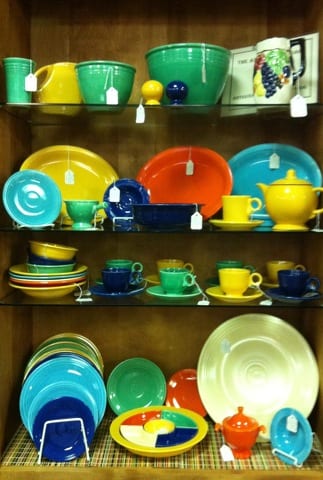STATE COLLEGE — It’s been around for more than 80 years and it’s still going strong. Fiesta — the colorful, bold, sturdy casual tableware — was loved in the 1930s and is still loved today.
While many items that once enjoyed popularity are no longer available, this iconic dinnerware lives on. While so much is now produced abroad, Fiesta is made in the same West Virginia factory on a bluff overlooking the Ohio River. Though kitchens and dining modes have changed dramatically, Fiesta still looks right.
What is the secret of Fiesta’s success? How come it’s still relevant after all this time?
The Homer Laughlin China Company, established in the 1870s, had always been a prolific producer of whiteware, handsome and tough pieces that rival English ironstone. Clays from deposits along the Ohio River were the raw material, and constantly improved techniques of firing made the company’s products superior.
Everything from utility pieces, such as pitchers and wash basins, to hand-painted dinnerware sets of the 1920s were made in the Newell, W.Va., factory. The company had a long and successful history of knowing what customers wanted, and, in 1936, when Fiesta was introduced, customers wanted to be cheered up.
It was the middle of the Great Depression and the feeling was that products should be “cheap and cheery” — cheap because no one had much money, and cheery because everyone needed to lift their spirits. This theme was picked up by the makers of kitchen and dining accessories. Vivid happy colors in simple, pleasing arrangements became the rule. Kitchen curtains, tablecloths and dish towels sported lively fruit and flower motifs. Tulips, cherries and lemons were everywhere. Bright clear reds, yellows, greens and blues were favored.
In keeping with this trend, glass companies started increasing production of what is now known as Depression Glass. Available at five-and-ten-cent stores were sets of patterned glass tableware in pretty shades of green, yellow, pink and blue. And, Homer Laughlin brought out its first six colors of Fiestaware — cobalt blue, red, green, yellow, ivory and turquoise.
Specifically designed to meet the needs and tastes of a Depression-weary populace, the colors reflected the choices of the time and coordinated with them. Each piece had concentric rings encircling the center, an Art Deco touch which complemented the prevailing style of the era.
But Fiesta didn’t stop there. As the Depression waned, new colors were added. Chartreuse, forest green, gray and rose came along in the 1950s. Medium green, the rarest of all the Fiesta colors, was produced in the 1960s. Antique gold and turf green flourished briefly in the early 1970s.
Production was halted in 1973 for economic reasons, then came roaring back in 1986. The design was essentially the same, while advances had increased its durability and gave glazes more luster. The back stamp was changed, making it obvious which Fiesta was vintage, even if colors were similar.
Now, new colors are introduced and other colors are retired each year, giving the serious collector 50 different colors to find.
Relevant today? Yes, certainly.
Fiesta plates, no matter their age or color, have a way of showing off food to advantage. They can go into the microwave and the oven and be washed in the dishwasher. They resist being easily broken or chipped, and there is a huge variety of items for food preparation, serving and dining.
A drive to Newell, on Route 30 just west of Pittsburgh, brings you to the factory and its seconds warehouse full of greatly discounted Fiesta in thousands of colors, shapes and sizes. It’s a feast for the eyes.
With its history and timeless design, there’s something appealingly nostalgic about Fiesta.



